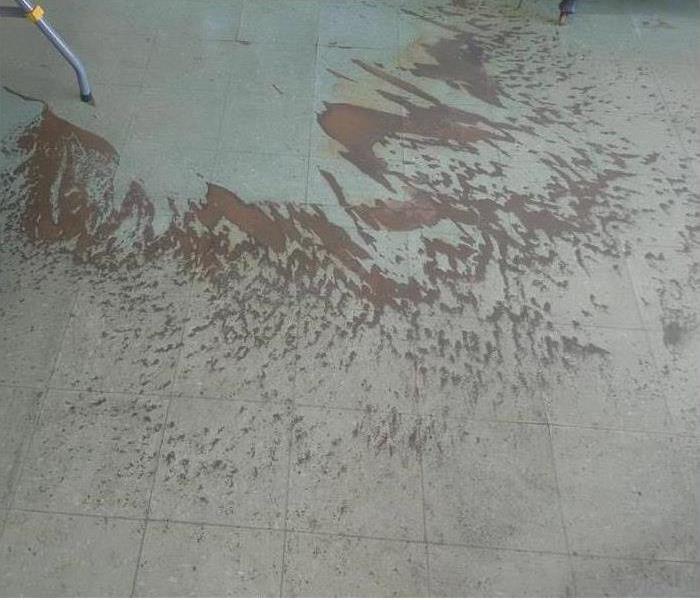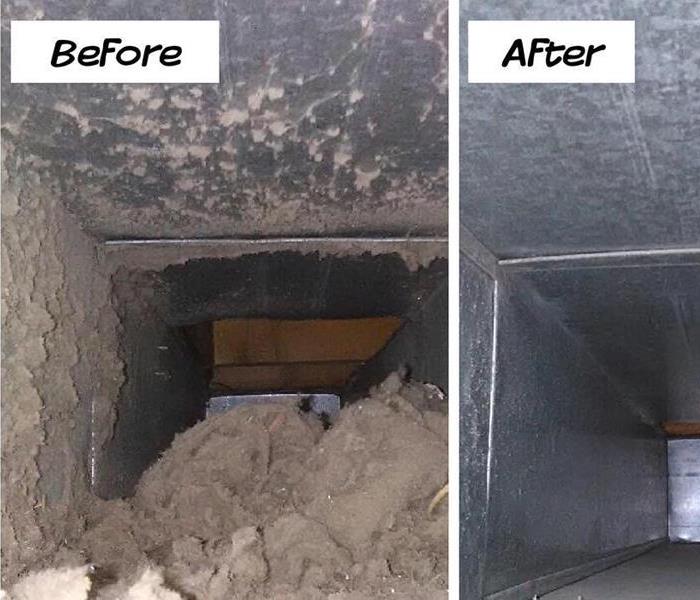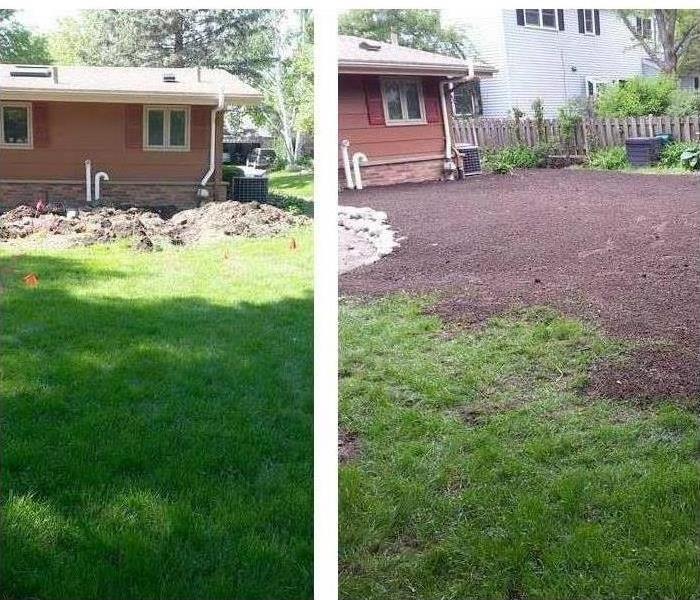Recent Posts
The Importance of Professional Mold Remediation: Why DIY Isn't Enough
10/21/2024 (Permalink)
Mold can be a persistent problem in homes, especially after water damage. While DIY solutions might seem like a cost-effective approach, professional mold remediation offers several key advantages.
1. Thorough Inspection and Assessment
SERVPRO® professionals conduct a comprehensive inspection to identify all mold-affected areas. Mold can hide in places you might not consider, such as behind walls or under flooring. Our thorough assessment ensures that all mold sources are identified and addressed.
2. Advanced Equipment and Techniques
SERVPRO uses advanced equipment and techniques for effective mold removal. From air scrubbers to HEPA vacuums, our tools are designed to eliminate mold spores from the air and surfaces, reducing the risk of recurrence.
3. Containment and Prevention
To prevent the spread of mold during the remediation process, SERVPRO sets up containment areas. This includes sealing off affected areas with barriers and using negative air pressure to keep spores from spreading to other parts of your home.
4. Comprehensive Cleaning and Sanitizing
Our team cleans and sanitizes all affected areas to remove mold spores and prevent future growth. SERVPRO’s specialized cleaning agents and techniques ensure that your home is safe and mold-free.
5. Restoration and Repairs
After the mold is removed, we focus on restoring your home to its pre-mold condition. This may include repairing damaged drywall, flooring, and other structural elements.
By choosing professional mold remediation from SERVPRO, you ensure a thorough and effective solution to your mold problem, protecting your home and health.
Fire Damage Restoration: How SERVPRO Helps You Rebuild After a Fire
10/21/2024 (Permalink)
Experiencing a fire in your home can be devastating. SERVPRO® is here to help you through the fire damage restoration process, ensuring your home is restored to its pre-fire condition.
1. Initial Assessment and Inspection
Upon arrival, SERVPRO conducts a detailed assessment of the fire damage. We inspect the extent of the damage to both the structure and contents of your home. This assessment helps us develop a comprehensive restoration plan tailored to your needs.
2. Board-Up and Tarping Services
To secure your property and prevent further damage, we provide board-up and tarping services. This step is crucial to protect your home from the elements and unauthorized entry.
3. Smoke and Soot Removal
Smoke and soot can cause significant damage and lingering odors. SERVPRO uses specialized equipment and techniques to remove smoke and soot from walls, ceilings, and other surfaces. Our goal is to clean all affected areas thoroughly.
4. Cleaning and Sanitizing
In addition to smoke and soot removal, we clean and sanitize your belongings. SERVPRO’s advanced cleaning methods and products help eliminate odors and restore your personal items.
5. Restoration and Reconstruction
The final step in the process is restoring and reconstructing your home. This may involve minor repairs, such as painting and installing new carpet, or major reconstruction of entire rooms.
By following these steps, SERVPRO ensures a comprehensive and effective fire damage restoration process, helping you rebuild your life and home after a fire.
Dealing with Flood Damage: Immediate Steps to Take Before Help Arrives
10/21/2024 (Permalink)
Floods can cause extensive damage to your home, but taking immediate action can help minimize the impact. Here are some steps to take before professional help arrives:
1. Ensure Safety First
Before entering your home, ensure it is safe to do so. Check for electrical hazards and structural damage. If there is standing water near electrical outlets or appliances, do not enter until a professional has assessed the situation.
2. Stop the Water Source
If the flooding is due to a burst pipe or another internal source, try to stop the flow of water if it's safe to do so. This may involve turning off the main water supply to your home.
3. Remove Excess Water
If possible, remove excess water using mops, buckets, or a wet/dry vacuum. Be cautious of contaminated water, and avoid using electrical appliances if the area is wet.
4. Move Furniture and Valuables
Move furniture, electronics, and other valuables to a dry area to prevent further damage. Place aluminum foil or wooden blocks under furniture legs to avoid staining carpets or flooring.
5. Ventilate the Area
Open windows and doors to allow for better air circulation. This helps with the drying process and reduces the potential for mold growth. If you have fans or dehumidifiers, use them to assist in drying out the affected areas.
6. Document the Damage
Take photographs and videos of the flood damage for insurance purposes. Documenting the extent of the damage can help with your insurance claim and ensure you receive adequate compensation.
7. Avoid Contaminated Water
Floodwater can be contaminated with bacteria, chemicals, and other hazardous materials. Avoid direct contact with floodwater and wear protective gear if you need to enter affected areas.
8. Contact Your Insurance Company
Notify your insurance company about the flood damage as soon as possible. They can provide guidance on the claims process and may help arrange for professional assistance.
9. Call SERVPRO® for Professional Help
Once you’ve taken the initial steps, contact SERVPRO for professional water damage restoration services. Our team is equipped to handle the full scope of water damage, from extraction and drying to cleaning and restoration.
By following these immediate steps, you can help mitigate the damage caused by flooding and ensure a smoother restoration process when professional help arrives.
Grease fires and what you need to know!
6/20/2023 (Permalink)
So, you’ve began to warm up the grease to fry some mouth watering French fries and all of a sudden the phone rings. The grease on the stove starts to overheat and smoke, and before you know it, the fryer catches on fire. What you do next to put out the grease fire is very important, so keep these tips in mind.
- Turn the heat off, but don’t move the container of grease.
- Don't pour water on a grease fire. Water could cause the grease to splash on other kitchen surfaces and possibly spread the flames.
- Put a lid on it. Covering the container will hopefully smother the fire.
- Call 911, if the fire has gotten out of control and get out of the building.
- Dont use flour on a grease fire. Sometimes using baking soda can put out a SMALL grease fire, but flour should never be used.
- Fire extinguisher should be the last resort, due to the risk of contaminating your kitchen.
Why choose us?
6/14/2023 (Permalink)
Here at SERVPRO of Lenoir, Duplin and Jones Counties we often get the question of Why SERVPRO? What is it that SERVPRO can do differently than all the other cleaning and restoration companies out there? The answer to those questions always start the same way, with the list of all the training and certifications held by SERVPRO employees, the systematic process that are used to manage different projects, and the support provided by corporate and the SERVPRO network. While those are all valuable assets, what truly sets SERVPRO of Lenoir, Duplin, and Jones Counties apart is the people. Between the office manager, production manager and our production team, they average 18 years of experience just with SERVPRO. This amount of experience provides them with all of the tools and knowledge necessary to handle projects of any type or size.
Whether it's routine carpet cleaning or a large commercial water loss or fire damage, the crew at SERVPRO Lenoir, Duplin and Jones Counties has the experience to make it "Like it never even happened."
Are you hurricane ready?
6/14/2023 (Permalink)
Are you prepared in case a hurricane hits the Lenoir, Duplin and Jones County Area. SERVPRO of Lenoir, Duplin and Jones Counties hopes everyone is prepared, but in case you're not here are 8 tips to make sure you are ready.
- Water. Be sure to buy enough bottled water to last your family several days. Each person normally needs at least a half-gallon per day.
- Food. Store at least 3-5 days of non-perishable food such as peanut butter, tuna, canned beans, cereals, protein bars, dried fruits, etc.
- Medications. Make sure you and other family members have your prescription medications on hand because the pharmacies may be out of stock for a couple of weeks after a storm.
- Cooler. If the electricity does go out, be sure to keep a cooler on hand to make sure your food and medications are kept cold until the power returns.
- Gasoline. Make sure at least one of your vehicles is filled with gas a day or 2 before the approaching storm is due to hit. Also, don't forget to fill your gas cans for your generator.
- Flashlights, Batteries & Weather Radio. If your electricity does go out, make sure you have a flashlight for each person. Store enough batteries to power your necessities for at least 3 days. Also, a weather radio can prove to be a very valuable item that every family should have no mater where you live.
- Disposable Items. Try to make sure you have things like paper plates, plastic utensils, diapers, paper towels and toilet paper, garbage bags, etc.
8. Comfort Items. To pass the time, make sure to have reading material, a deck of cards, board games, etc. Also, keep your kids comfort items close by. It's nice to have something to keep them busy and calm.
These are probably the most important tips to apply when preparing for a hurricane. We, here at SERVPRO of Lenoir, Duplin, and Jones Counties, hope none of this is ever needed. This is information that will prove very useful if a hurricane should hit our area.
Are you prepared for spring and summer storms?
3/24/2023 (Permalink)
Storms don’t wait for regular business hours to strike, that's why you need to call the professionals here at SERVPRO of Lenoir, Duplin & Jones Counties, who are available to you 24 hours per day, 7 days per week, 365 days per year.
We understand the process of helping you to put your life back together when a storm hits. Allow us here at SERVPRO of Lenoir, Duplin & Jones Counties to show you what several other family members have previously experienced-our willingness to help make your life normal again.
Advance planning for thunderstorms, lightning, tornadoes, and floods requires specific safety precautions. You can follow many of the same steps for all extreme weather events like keeping an emergency kit on hand. Some items to include are:
- A battery-operated flashlight, a battery-operated NOAA Weather Radio, and extra batteries for both
- An emergency evacuation or shelter plan including a map of your home and, for every type of severe weather emergency, routes to safety from each room
- A list of important personal information such as,
- telephone numbers of neighbors, family, and friends
- insurance and property information
- telephone numbers of utility companies
- medical information
- According to the American Red Cross an emergency kit may include:
- non-latex gloves
- assortment of adhesive bandages
- antibiotic ointment
- sterile gauze pads in assorted sizes
- absorbent compress dressings
- tweezers
- scissors
- adhesive cloth tape
- aspirin packets (81 mg each)
- first aid instruction booklet
- A 3–5 day supply of bottled water and nonperishable food
- Personal hygiene items
- Blankets or sleeping bags
We are hoping for a mild storm season but in the event you suffer a loss caused by storm damage, call us at (252)208-7888
What you need to know about sewage backups
4/4/2022 (Permalink)
 Did you know that a sewage back up is considered a biohazard?
Did you know that a sewage back up is considered a biohazard?
It usually begins with a gurgling... or a slow drain. If you notice either, your number may be up. When confined to a single drain, you probably don't have anything to worry about - break out the plunger or pull out that hair clump. But if the tub is backing up when the toilet's flushed, or the kitchen sink appears to drain straight to your basement, you could have a major problem. The sewer drain could be backing into your building drain.
Did you know...
- The most common causes of sewer backups are tree roots clogging pipes, FOG (Fats, Oils, and Grease) going down the drain, and connecting things like french drains, sump pump discharges, and other flood control systems to the sanitary sewer system (which is why such connections are usually not permitted). Blockages in main sewer lines can also be caused by soil settlement over time or collapsed pipes.
- "Flushable" wipes aren't so flushable: utilities around the country have found them to be the chief culprit in many a clogged main sewer drain. Trash them!
- Municipalities with combined sewage and storm water systems are at a higher risk of being inundated by severe rainfall, resulting in backups.
Sewage backups can put you in a messy situation but we can take care it quickly! If you suffer a sewage back up, call 252-208-7888 for a quick response and we will make it "Like it never even happened."
What is in your ducts?
4/4/2022 (Permalink)
 How is your indoor air quality?
How is your indoor air quality?
Have you ever stopped to consider the air that circulates inside your home? It travels from your furnace, through your ductwork, into your home’s air, and back through the cold air return system. On its journey, it accumulates all kinds of nasty stuff: dust, hair, allergens, pet dander, mold spores, you name it. If it’s airborne, it will eventually collect in your ductwork.
From there, it will get blown out into your home, making a dusty, dirty mess of your indoor air (you know, the stuff you breathe). The Benefits of Professional Air Duct Cleaning Purify Your Indoor Air. Getting rid of all the nasty particulate in your duct-work will help clean up the air inside your home.
SERVPRO of Lenoir, Duplin & Jones has a comprehensive cleaning system that ensures every square inch of your duct-work is thoroughly cleaned, helping you breathe easy in your own home. Reduce Allergies. While the seasons determine the severity of most allergy issues, homes with congested ventilation can cause allergic reactions year round. Contaminants such as dust, mold spores, pet dander and dirt accumulate in your air ducts over time and are blown around into various rooms in your house, preventing the allergy sufferers in your home from ever experiencing total relief. Less Dusting. Getting rid of the dust in your indoor air means less dust on your furniture/pictures/counters/everywhere!
Who wouldn’t want to cut down on the tiresome chore of dusting? Improve Furnace Efficiency. Removing the dust, dirt, and debris from your HVAC system will help your furnace run better! Instead of heating the mess inside the vents, the heat generated by the furnace is more easily transferred through the ducts into your home’s air. As any homeowner will tell you, running a furnace is expensive! Don’t make your furnace work any harder than it needs to.
CALL US AT 252-208-7888 and get cleaner, healthier indoor air!
How does your home rate in preventing water damage?
3/20/2022 (Permalink)
 Making sure that your yard is graded correctly is important
Making sure that your yard is graded correctly is important
Certain factors which eliminate the potential for water damage should be a top priority whether you are shopping for a pre-existing home or property on which you plan to build your own home. Yard grading is a construction or landscaping technique that changes a property’s directional slope.
A pre-existing home that sits on land that slopes downward towards its foundation could be in for destruction after heavy rains, storms and melting snow. Changing the grade to slope away from its foundation effectively could eliminate these risks.
Yard grading around a pre-existing structure can be accomplished by clearing all landscaping within a five-foot area around the home’s perimeter. Low-lying spots or lawn dips could result in post-storm mud and small pools of water. Fill the dips up with clean soil and use a compactor to tamp down the soil.
Another method some homeowners choose to employ is to install a dry creek bed straight up the middle of their land and fill it in with attractive river rocks. This bed-like feature draws runoff deep down into the earth, keeping above-ground outbuildings dry.
If you are considering designing your own home, it’s a lot cheaper to change the home's design than regrade the ground. Draw home plans with the structure on highest ground point. Try to leave at least six inches between the home’s perimeter and landscape plantings.
Some homeowners install gutter systems that are easy to maintain consistently or place river rocks around downspouts, so runoff doesn’t create sinkholes. Homeowners may choose to install double-pane windows or water resistant flooring. Central heat and air units with dehumidifying systems could also help. Area rugs made from natural fibers that are washable and furniture made of moisture repellent materials like bamboo could also prevent moisture build up. Be sure to insulate any plumbing against condensation and
seal air ducts thoroughly, paying close attention to adjoining seams.
Once you have established a safe, water-tight home environment, you are ready to move into your new residence.



 24/7 Emergency Service
24/7 Emergency Service


